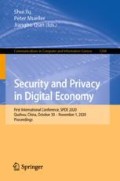Abstract
This paper proposes an idea of data computing in the covert domain (DCCD). We show that with information hiding some data computing tasks can be executed beneath the covers like images, audios, random data, etc. In the proposed framework, a sender hides his source data into two covers and uploads them onto a server. The server executes computation within the stego and returns the covert computing result to a receiver. With the covert result, the receiver can extract the computing result of the source data. During the process, it is imperceptible for the server and the adversaries to obtain the source data as they are hidden in the cover. The transmission can be done over public channels. Meanwhile, since the computation is realized in the covert domain, the cloud cannot obtain the knowledge of the computing result. Therefore, the proposed idea is useful for secure computing.
Access this chapter
Tax calculation will be finalised at checkout
Purchases are for personal use only
References
Chen, J., Ping, J., Xu, Y., Tan, B.: Information privacy concern about peer disclosure in online social networks. IEEE Trans. Eng. Manage. 62(3), 311–324 (2015)
Liu, G., Wang, C., Peng, K., Huang, H., Li, Y., Cheng, W.: SocInf: membership inference attacks on social media health data with machine learning. IEEE Trans. Comput. Soc. Syst. 6(5), 907–921 (2019)
Mustafa, A., Khan, S., Hayat, M., Shen, J., Shao, L.: Image super-resolution as a defense against adversarial attacks. IEEE Trans. Image Processing 29, 1711–1724 (2020)
Puteaux, P., Puech, W.: An efficient MSB prediction-based method for high-capacity reversible data hiding in encrypted images. IEEE Trans. Inf. Forensics Secur. 13(7), 1670–1681 (2018)
Zhang, X.: Reversible data hiding in encrypted image. IEEE Signal Process. Lett. 18(4), 255–258 (2011)
Qian, Z., Xu, H., Luo, X., Zhang, X.: New framework of reversible data hiding in encrypted JPEG bitstreams. IEEE Trans. Circ. Syst. Video Technol. 29(2), 351–362 (2019)
Ren, Y., Zhang, X., Feng, G., Qian, Z., Li, F.: How to extract image features based on co-occurrence matrix securely and efficiently in cloud computing. IEEE Trans. Cloud Comput. 8(1), 207–219 (2020)
Zhang, Q., Yang, L., Chen, Z.: Privacy preserving deep computation model on cloud for big data feature learning. IEEE Trans. Comput. 65(5), 1351–1362 (2016)
Zhang, X., Wang, Z., Yu, J., Qian, Z.: Reversible visible watermark embedded in encrypted domain. In: 2015 IEEE China Summit and International Conference on Signal and Information Processing (ChinaSIP2015), Chengdu, China, pp. 826–830, July 2015
Li, M., Li, Y.: Histogram shifting in encrypted images with public key cryptosystem for reversible data hiding. Signal Process. 130(9), 190–196 (2017)
Zhang, X., Long, J., Wang, Z., Cheng, H.: Lossless and reversible data hiding in encrypted images with public key cryptography. IEEE Trans. Circ. Syst. Video Technol. 26(9), 1622–1631 (2016)
Chen, Y., Shiu, C., Horng, G.: Encrypted signal-based reversible data hiding with public key cryptosystem. J. Vis. Commun. Image Represent. 25(5), 1164–1170 (2014)
Fridrich, J., Soukal, D.: Matrix embedding for large payloads. IEEE Trans. Inf. Forensics Secur. 1(3), 390–395 (2006)
Ren, Y., Dong, M., Qian, Z., Zhang, X., Feng, G.: Efficient algorithm for secure outsourcing of modular exponentiation with single server. IEEE Trans. Cloud Comput. (2018). https://doi.org/10.1109/TCC.2018.2851245
Dong, M., Ren, Y., Zhang, X.: Fully verifiable algorithm for secure outsourcing of bilinear pairing in cloud computing. KSII Trans. Internet Inf. Syst. 11(7), 3648–3663 (2017)
Liang, H., Zhang, X., Cheng, H.: Huffman-code based retrieval for encrypted JPEG images. J. Vis. Commun. Image Represent. 61, 149–156 (2019)
Cheng, H., Zhang, X., Yu, J.: AC-coefficient histogram- based retrieval for encrypted JPEG images. Multimed. Tools Appl. 75(21), 13791–13803 (2016)
Peng, T., Liu, Q., Wang, G.: Enhanced location privacy preserving scheme in location-based services. IEEE Syst. J. 11(1), 219–230 (2017)
Li, S., Chen, X., Wang, Z., Qian, Z., Zhang, X.: Data hiding in iris image for privacy protection. IETE Tech. Rev. 35(S1), 34–41 (2018)
Schaefer, G., Stich, M.: UCID - an uncompressed colour image database. In: Proceedings of Conference on Storage and Retrieval Methods and Applications for Multimedia, San Jose, CA, USA, pp. 472–480, January 2004
Wang, Z., Qian, Z., Zhang, X., Yang, M., Ye, D.: On improving distortion functions for JPEG steganography. IEEE Access 6, 74917–74930 (2018)
Pevny, T., Bas, P., Fridrich, J.: Steganalysis by subtractive pixel adjacency matrix. IEEE Trans. Inf. Forensics Secur. 5(2), 215–224 (2010)
Fridrich, J., Kodovsky, J.: Rich models for steganalysis of digital images. IEEE Trans. Inf. Forensics Secur. 7(3), 868–882 (2012)
Holub, V., Fridrich, J.: Random projections of residuals for digital image steganalysis. IEEE Trans. Inf. Forensics Secur.ty 8(12), 1996–2006 (2013)
Kodovsky, J., Fridrich, J., Holub, V.: Ensemble classifiers for steganalysis of digital media. IEEE Trans. Inf. Forensics Secur. 7(2), 432–444 (2012)
Acknowledgement
This work was supported by the Natural Science Foundation of China (Grant U1736213, 62002214).
Author information
Authors and Affiliations
Corresponding author
Editor information
Editors and Affiliations
Rights and permissions
Copyright information
© 2020 Springer Nature Singapore Pte Ltd.
About this paper
Cite this paper
Qian, Z., Wang, Z., Zhang, X. (2020). Data Computing in Covert Domain. In: Yu, S., Mueller, P., Qian, J. (eds) Security and Privacy in Digital Economy. SPDE 2020. Communications in Computer and Information Science, vol 1268. Springer, Singapore. https://doi.org/10.1007/978-981-15-9129-7_37
Download citation
DOI: https://doi.org/10.1007/978-981-15-9129-7_37
Published:
Publisher Name: Springer, Singapore
Print ISBN: 978-981-15-9128-0
Online ISBN: 978-981-15-9129-7
eBook Packages: Computer ScienceComputer Science (R0)

